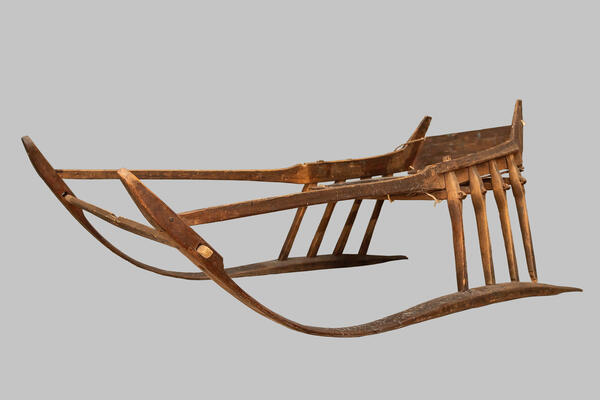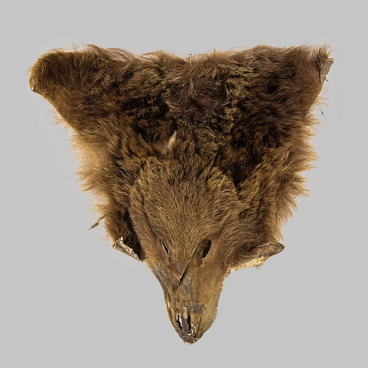Two-pole driving reindeer sleds are exhibited at the Tobolsk Provincial Museum. The peoples of the North of Western Siberia have always made sleds by taking into account the specifics of what they would ride. For example, women’s sleds were always made a little longer than men’s sleds, since they were also used by children. In addition, such sleds were made slightly lower than men’s ones so that a woman’s foot could reach the runners.
The master made this instance of winter sleds from coniferous wood. The runners were cut out from straight bars and bent up, and the rear ends were cut off for greater mobility of the sled. A seat with a short wide back is fixed on the elms, i.e. square sticks that the master connected the runners with four hooves set vertically on each side.
The master made this instance of winter sleds from coniferous wood. The runners were cut out from straight bars and bent up, and the rear ends were cut off for greater mobility of the sled. A seat with a short wide back is fixed on the elms, i.e. square sticks that the master connected the runners with four hooves set vertically on each side.
Reindeer sledding is the most ancient and widespread method of transportation among different peoples of the Far North. Sleds were invented almost two thousand years ago, and since then their design has changed little. To the uninitiated, it may seem that controlling the deer is quite easy. In fact, residents of the tundra learn this from childhood by mastering all the difficulties and secrets of controlling a team that can reach speeds of up to 40 km/h, which is comparable to riding a snowmobile. A speed of 10 km/h is considered an average operating speed.
The deer were controlled in two ways. By the voice, as well as using reins and a thin pole with two tips, i.e. the iron tip to rest on the ground, and the bone one to drive animals. Each reindeer herder has its own set of voice commands to control the team. They are shouted very loudly and clearly. Otherwise, the animal simply will not hear anything or, as it is believed, will not want to hear, since deer are intelligent and have very fine hearing and smell. If the herder has been raising the deer since they were young, they can develop their own set of commands to help them control.
Most of the commands are given to the deer using a long pole. The driver works it with the leading animal, and all the others follow him. In order for the deer to speed up, the animal in front of them is patted on the back with the tip of the pole. To turn, you need to touch one or another side of the animal, and the stop occurs after the reindeer herder pulls the reins on himself.
Most of the commands are given to the deer using a long pole. The driver works it with the leading animal, and all the others follow him. In order for the deer to speed up, the animal in front of them is patted on the back with the tip of the pole. To turn, you need to touch one or another side of the animal, and the stop occurs after the reindeer herder pulls the reins on himself.



